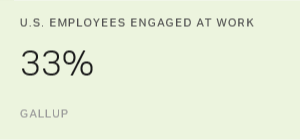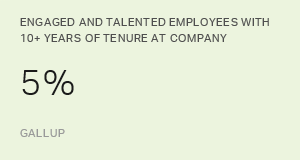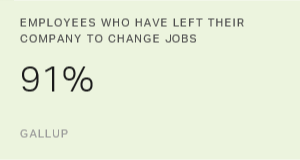Story Highlights
- Organizations must reconsider how they manage their workforces
- Employees are pushing companies to break down long-established structures
- Organizations are not giving employees compelling reasons to stay
"The workplace is changing."
Leaders hear this declaration all the time. In the past, it carried little weight because change is a constant in the business world.
So, why does it feel different now? Why does "change" feel so pervasive?
Because the changes that are affecting organizations today are coming at a dizzying pace. They're overlapping and colliding in ways they haven't before. They're historic and monumental.
According to Gallup's State of the American Workplace report, releasing today, these changes are forcing organizations to reconsider how they manage employees in a time when the very essence of how, when and where people work -- and the value they place on work -- is shifting.
Employees Are Pushing Employers to Forgo Traditional Structures
Forces colliding in the workplace are putting stress on the traditional ways of managing and structuring work. New and emerging technologies are transforming the type of work employees perform, as well as where and how work gets done.
As the nature of teams becomes more complex, organizations need to become more agile and collaborative than before. More people do their jobs virtually or remotely and at various times of the day. This is resulting in coworkers having fewer face-to-face interactions and communicating increasingly through email, instant messaging and conference calls.
At the same time, "matrixed" structures that cut across projects and functions are everywhere. While these structures have their benefits, they can leave employees feeling more confused about expectations and with less time to do their work.
What's more, employees are pushing companies to break down the long-established structures and policies that traditionally have influenced their workdays. Employees' attitudes about what a job should and should not be are evolving.
Most workers, many of whom are millennials, approach a role and a company with a highly defined set of expectations. They want their work to have meaning and purpose. They want to use their talents and strengths to do what they do best every day. They want their jobs to fit their life. And they are less interested in settling.
As the job market has opened up, employees have been feeling increasingly optimistic about what they're finding. A record 47% of the workforce says that now is a good time to find a quality job (up from 19% in 2012), and more than half of employees (51%) are searching for new jobs or watching for openings.

Employees Feel Indifferent About Their Jobs
Only one-third of U.S. employees are engaged at work. And only about one in five say they're managed in a way that motivates them to do great work. Bluntly, many employees feel indifferent about their jobs.
Gallup finds they also have little faith in their company's leadership:
- 22% of employees strongly agree that the leadership of their organization has a clear direction for the organization
- 15% of employees strongly agree that the leadership of their organization makes them enthusiastic about the future
- 13% of employees strongly agree that the leadership of their organization communicates effectively with the rest of the organization
Organizations aren't giving employees enough compelling reasons to stay. So it's no surprise that most employees (91%) say that the last time they changed jobs, they left their company to do so.
Regardless of all the changes in the workplace, people remain essential to an organization's success or failure. Of course, leaders have to think about their technology, policies, products and services -- but that's only because these are factors that influence the engagement and success of their employees. The key to an organization's growth has been -- and always will be -- its workforce.
The truth is, organizations have nowhere to hide. They have to adapt to the needs of the modern workforce. If they don't, they'll struggle to attract and keep great employees and, therefore, customers.
Analytics and Advice for Managing the Modern Workforce
Gallup created the State of the American Workplace report to help leaders cut through the clutter. The report provides analytics and advice on various aspects of the modern workforce, pinpointing the issues that matter most in attracting, retaining and engaging employees.
The report reveals an unsettling pattern in the U.S. workplace, one that leaders need to respond to if they want to get the most out of their workforce. The one thing leaders cannot do is nothing. They cannot wait for trends to pass them by, and they cannot wait for millennials to get older and start behaving like baby boomers. That won't happen. This workforce isn't going to acclimate to the status quo.
The rulebook is being rewritten. There is a sense of urgency for leaders to define and convey their vision more clearly and to rally their employees around it. Leaders must decide what role they want to play in their organization -- now, in the midst of change, and in the future. They can be passive bystanders or active participants in creating and guiding an exceptional workplace.
This article is part of Gallup's State of the Workplace Initiative. To learn more, we invite you to:
- download the most recent State of the American Workplace report
- attend a complimentary briefing in your area about this initiative


